Staircase luminaires

A staircase is not only a functional and useful structure, but also a high-risk object. Proof of this is the large percentage of household injuries sustained when interacting with these structural elements.
Just equipping the house with marches is not enough, you need to reduce the risks arising in the process of using them to the possible minimum. It is important to bear in mind that moving at an angle is always accompanied by some discomfort and is associated with a certain physical activity.
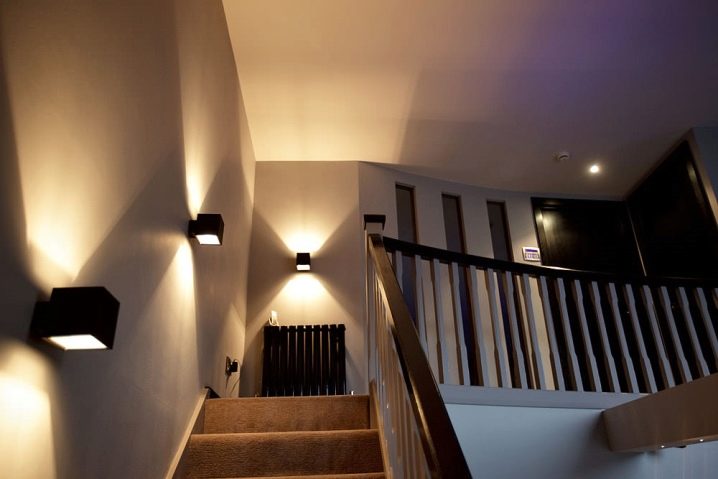
There are universal solutions designed to increase the safety and comfort of stair flights. One of these solutions is their full coverage. Let's talk about how to correctly plan staircase lighting and what types of lighting fixtures will ensure the successful implementation of the task.
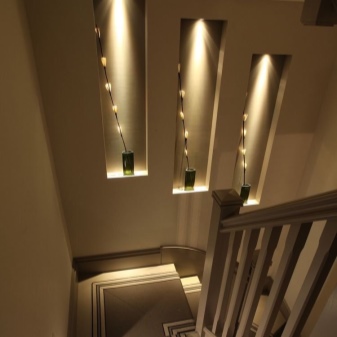

Advantages
Today, the lighting of auxiliary areas - corridors, hallways and staircases - is given the same importance as artificial light sources in the main rooms.
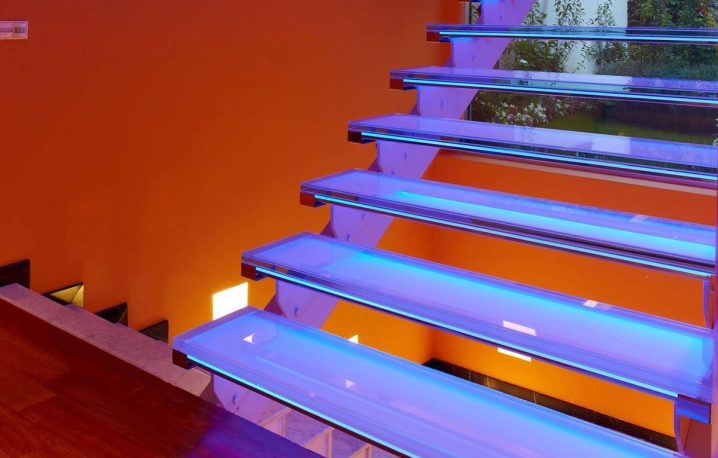
When it became customary to create a two-level space and include stairs in the common living area of houses and apartments, they ceased to be perceived as purely functional areas, and began to use decorative qualities to increase the attractiveness of the visual component of housing. At the same time, well-organized lighting of the marches solves specific problems - functional, aesthetic and psychological.
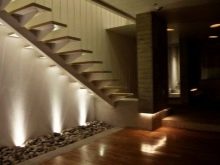


The main functions of the light:
- creates the necessary degree of illumination, which contributes to the convenient and safe use of the staircase for its intended purpose;
- provides psychological comfort of movement along the flight, softening our perception of a closed space, which assumes only two directions of movement, becoming a reference point;
- acts as a decorative element, contributing to the interior design;
- plays the formative role of organizing the usable area: if necessary, visually unites the stairs and the rest of the rooms, or separates it from them.
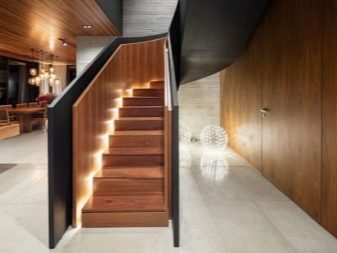
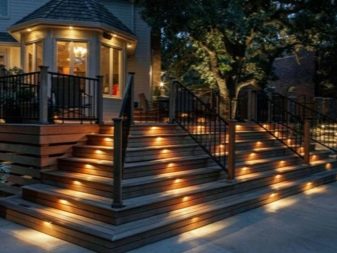
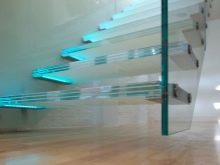
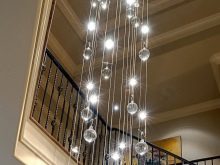

Lighting selection rules
To organize the lighting on the stairs, you need to consider a number of points.
The location of the stairs inside / outside the residential building
Outside structures are illuminated with general lighting both throughout the backyard area and locally. Powerful outdoor lighting fixtures are usually compact models of floodlights or lanterns.
Street lighting must meet increased requirements: be frost-resistant and withstand temperature fluctuations.
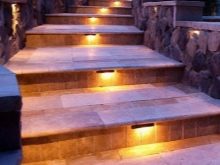

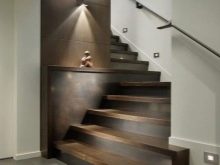
The lamps, which illuminate the steps, are attached to the structures of houses, independent supports, and cable connections. Power is supplied via overhead / underground cables.
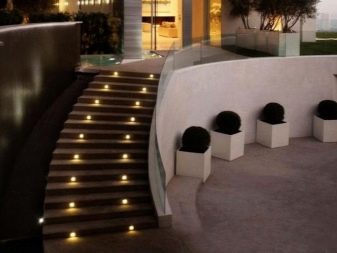

Presence / absence of windows, stained glass
If the room has natural light sources, then in the daytime the flight of stairs is well lit and even better in sunny weather. But they no longer fully satisfy the need for natural light when it is cloudy or with the onset of dusk.Therefore, the lack of light is compensated for by lighting fixtures.
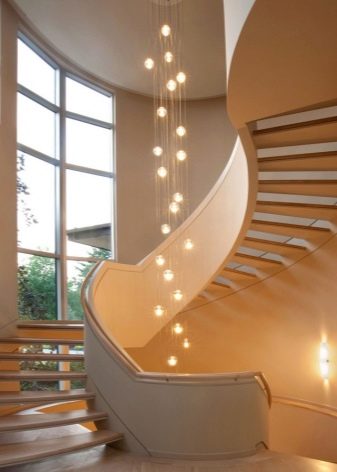
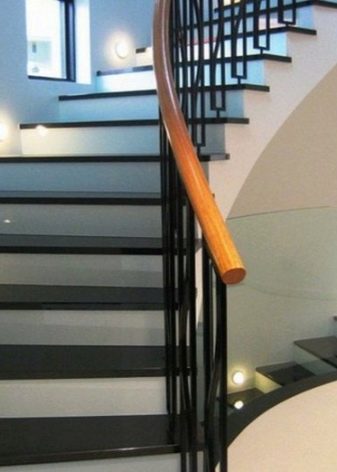
In most cases, there are no windows in basements and attics. In the absence or deficiency of natural light, the problem is solved by diffused lighting, which will illuminate the march around the clock.
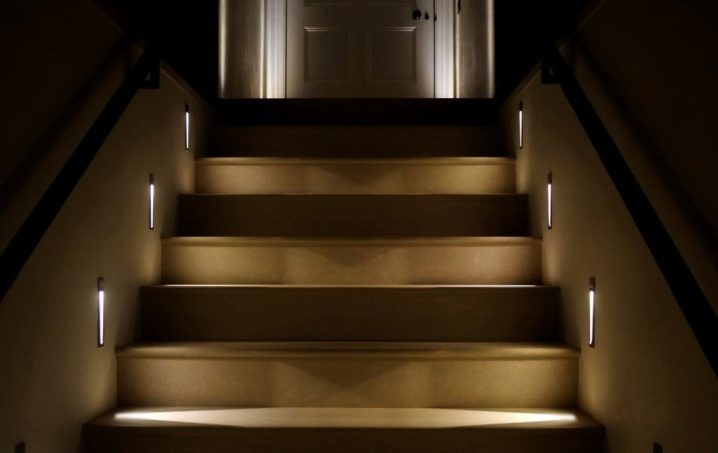
Construction type
It is logical that planning the lighting of rectilinear, arcuate and curved inclined structures has to be done in different ways. If, when equipping a single-march structure, it is possible to limit the illumination of its beginning and end with the help of automatic lamps, then this is clearly not enough for a spiral structure.
In this case, it is best to illuminate the steps to ensure good visibility underfoot when descending or ascending.
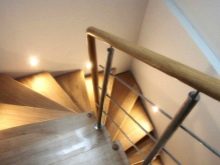
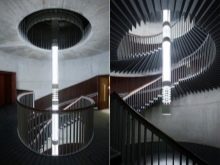
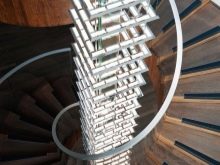
Lift length
It is recommended to equip long staircases with lamps of diffused light in order to avoid increased stress on the organs of vision during long transitions. Spotlights are enough for short climbs, since this will not affect the comfort and safety of the walker.
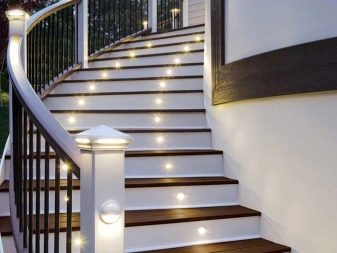
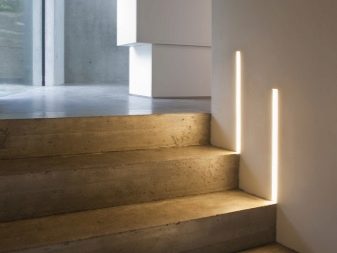
Dimensions, design and number of lighting fixtures are determined individually, taking into account specific conditions, stylistic performance of stairs, functional purpose of the premises in which they are located.

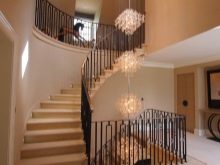
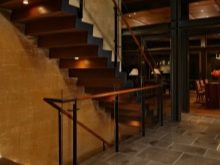
Views
In addition to sources of direct and diffused light, lamps with reflected light and combinations of lighting devices of various types are used in stairwells and adjacent areas.
Regardless of which of the listed options you use, it is important to comply with the following requirements:
- achieve an even distribution of light throughout the entire length of the flight of stairs;
- ensure good visibility of all steps, which is possible with sufficient luminaire power;
- provide for the correct direction and intensity of light fluxes: they should not dazzle when going up or down.
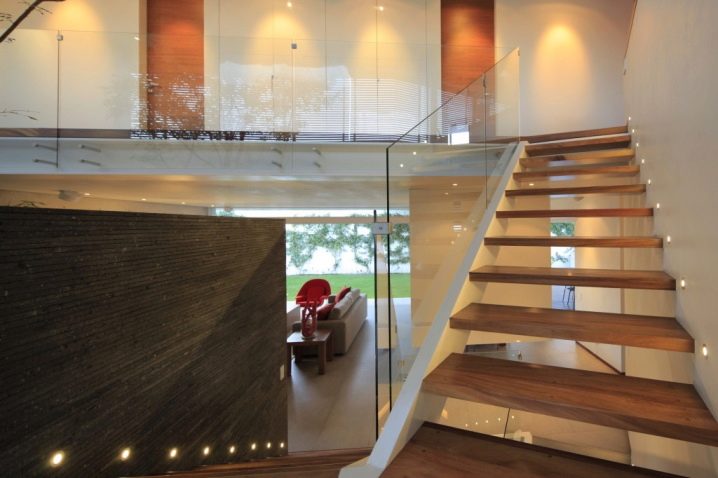
Lighting devices are involved in organizing general lighting, local (point) lighting to create spots of light in the right places and decorative lighting that emphasizes the volume and depth of objects. When choosing luminaires, the degree of illumination of the room, the directivity and brightness of the total luminous flux are taken into account.
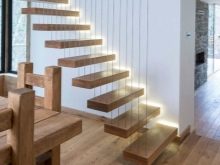
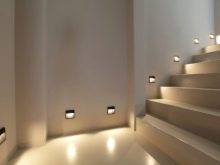

Ceiling light options
To illuminate large, most often front staircases with several spans and adjacent landings, it is advisable to resort to the help of chandeliers with long hangers.
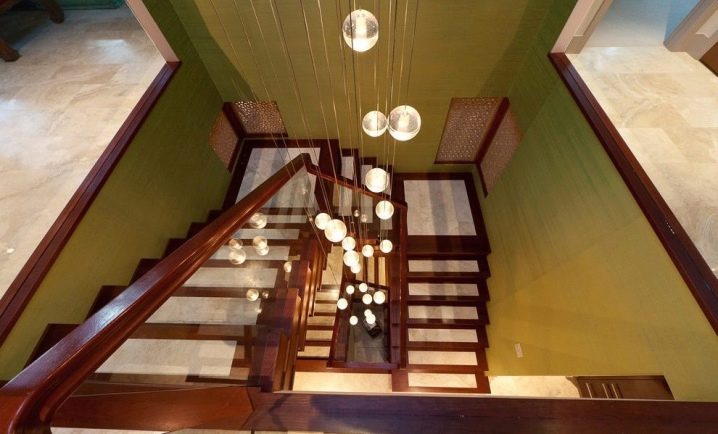
Due to the even distribution of light rays, the illumination is soft and does not irritate the eyes. Multi-tiered spiral models with an abundance of glass balls, in the form of a cascade of crystal "tears" or luminous columns, give the marches an elegant and sophisticated look. A winning solution is a forged chandelier with a brass or bronze frame part in combination with a cast-iron march and a wrought-iron railing.
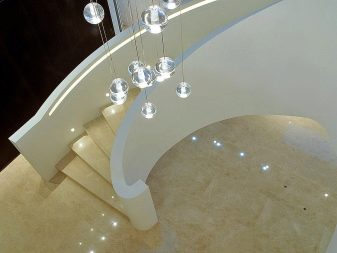
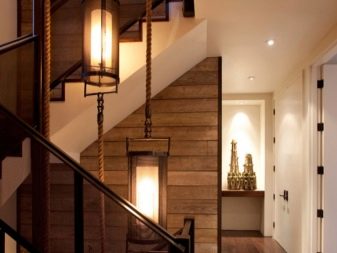
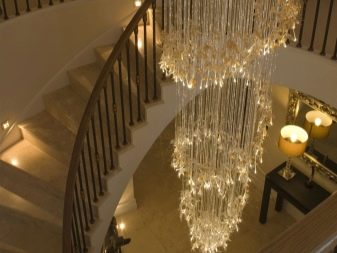
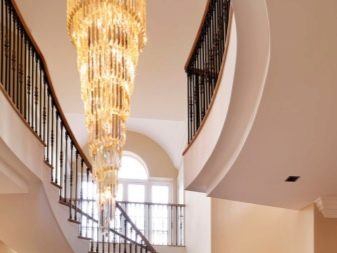
Chandeliers are often used to create an additional light accent in the staircase area, emphasizing the details of the inclined structure. They also help out in a situation where the march is designed in the central part of the premises, which does not imply the joining of the first span of its structure and the wall, so the only option is ceiling lighting.
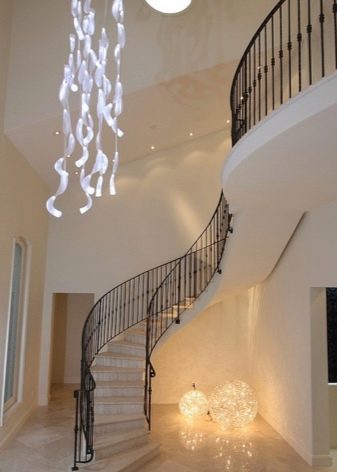
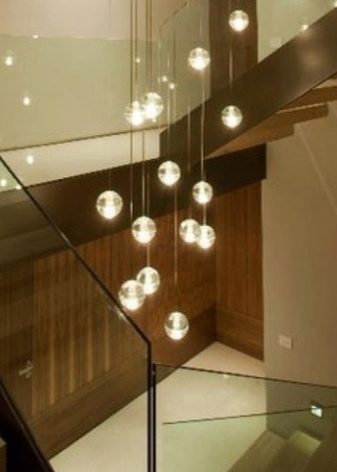
Features of wall lights
The most common way of organizing staircase lighting involves combination of luminaires of different types, namely:
- surface models, when the lamps are attached to the wall behind the back. This fixation option excludes the possibility of changing the direction of the rays of light, since the shades do not rotate. Advantages: the creation of uniform diffused lighting and the compactness of the placement of lighting devices, which allows you to decorate in this way even very wide marches;
- sconce with bracket-base, which provides the ability to mount lamps at different distances from the walls.This lighting option is universal, since it organically complements any interior solution. Some models of sconces have a swivel mechanism to change the direction of light;
- recessed luminaires, however, the minimum installation depth is 4 cm. The package includes fixed or movable heads to facilitate changing the direction of the light flux.
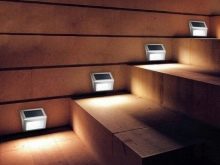

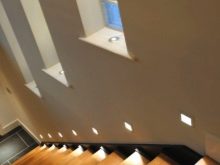
The design of most models of built-in lamps is focused on interior decoration in modern hi-tech, techno, loft styles, where laconic forms and austere look are welcome. The design of wall lamps (shades, lampshades, compositions of pendants) is of two types: closed to create uniform illumination of the march and open with a clear direction of the light flux up or down, parallel to the steps. Dim lighting is provided by shades of glass, crystal, plastic and lampshades of their dense textiles, rice paper.
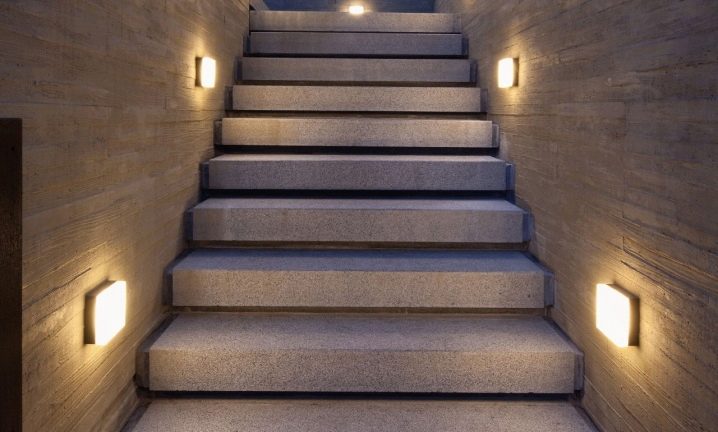
Local lighting: LED lights
In an original way, individual elements of the staircase space can be played up - the steps allow LED lighting devices. LED-backlighting gives expressiveness to the design of marches, at the same time acting as an additional source of light. The vertical surface of the steps is equipped with separate surface-mounted luminaires in the central or lateral part. An interesting option is when the lamps "recessed" inside the wide march step, embedding lamps in the immediate vicinity of the railing.
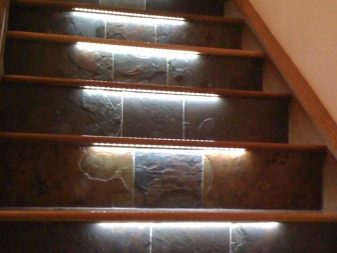
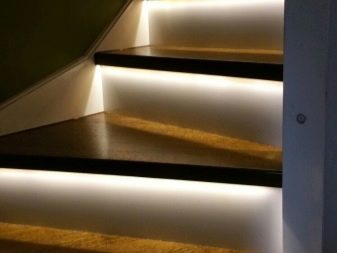
Arguments for using LEDs:
- attractive appearance;
- easy installation;
- long service life - on average 10 years;
- ease of use - a remote control is provided to adjust the intensity of the luminous flux and color;
- safety - the tape is powered by a 12 Volt unit;
- profitable price;
- low power consumption and, as a result, the ability to save on electricity bills.
The tapes are inserted into special profiles that protect the LEDs from contact with water, various kinds of dirt and mechanical damage.
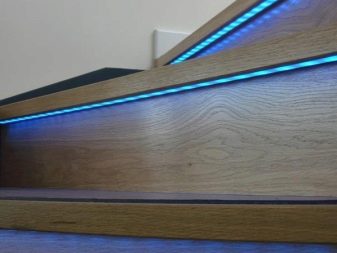

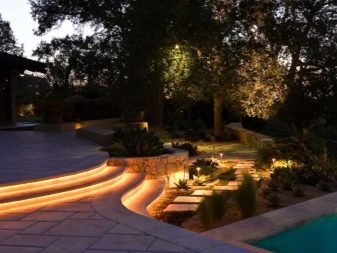

Benefits of automatic route highlighting
The use of stairs from time to time does not require the use of lighting devices in a constant mode. In such situations, an automatic backlight with motion sensors is installed, equipping all stages of the structure or one stage at the entrance / exit.
Advantages of automatic lamps:
- save energy;
- Provide comprehensive customization of lighting fixtures;
- look spectacular;
- solve the problem of finding switches at nightfall.
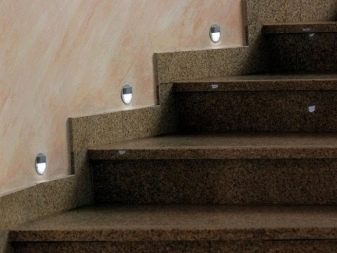

Motion sensors react to moving objects that fall within their coverage area by transmitting a signal to the lighting systems, as a result of which they turn on. The light is switched off automatically, after a certain time from the moment the movement was stopped.
In other machines, acoustic sensors are provided that turn on the light, reacting to the noise produced by the steps of a person falling within the range of the device. In both types of machines there are light sensors that are responsible for turning on the lamps in cases of insufficient illumination of the staircase.
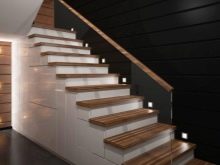
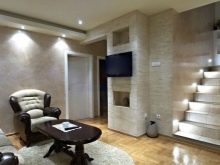
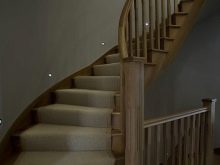
Such devices successfully interact not only with classic models of lighting fixtures, but also with LED strips. If desired, the machines are configured so that the illumination of the steps turns on gradually, as the user descends or climbs.
Backlight options
Lighting planning in a cottage or private house requires careful attention to detail. Complicating the task is the need to highlight a two-level space, where there is necessarily one or more marches. To create additional comfort, general lighting sources are combined with local ones.This implies the placement of lamps along the functional junction of marches and walls, maintaining the same step, for detailed illumination of the steps.
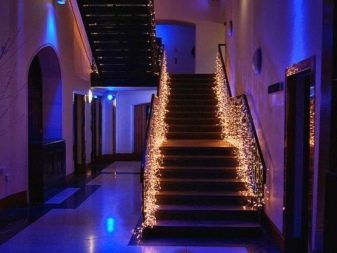
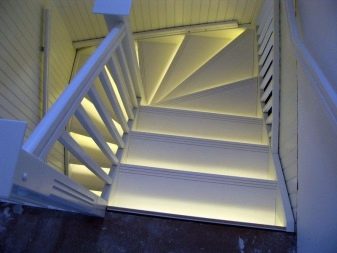
Installation of lighting along the steps in a private house involves several options for arranging light sources:
- on the wall along the structure above the average human height: so they will not blind the walking person - once and touch the head - two;
- inside the wall at knee height;
- on the side of the steps to the second floor, spotlights are placed;
- under the tread of each step with LED strips.
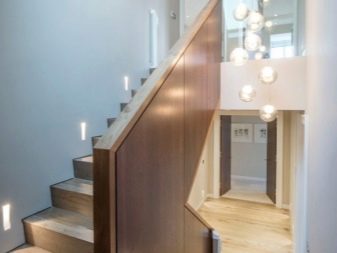
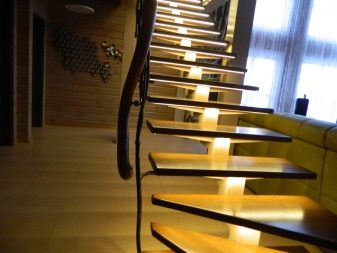
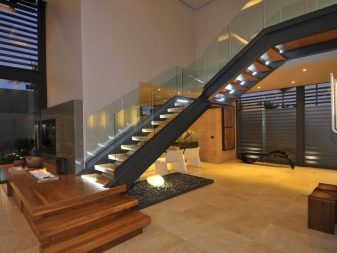
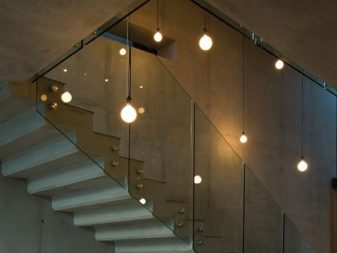
Often, additional lighting is required at the beginning or end of the staircase or railings. Therefore, the entrance / exit of the march is equipped with directional light fixtures, and, subject to its increased length, light sources are located throughout, plus flexible fluorescent cords are used to illuminate the handrails. They are placed behind the handrails along the handrail guide.
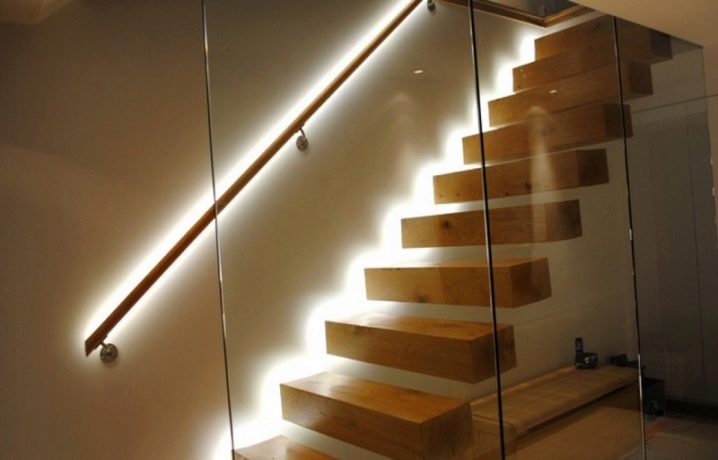
Light control
Due to the design features of the staircase spaces, the installation of familiar switches loses its meaning, since they stand on structures on one floor and leave them on the other. Switches with a switch function are relevant here. When the user gets up on the march, he turns on the light with the corresponding button, and after finishing the ascent, turns off the lighting with another button, which belongs to the same switch.
For information on how automatic staircase lighting with motion sensors works, see the following video review.
Installing large-sized ceiling lights is a reason to get a dimmer - a special regulator of the intensity of the level of illumination of the room from dim light to the most bright one.
There are timers that can turn off / off the light themselves at certain intervals. But for private households, these devices are not particularly suitable, due to the large area of such buildings. Another thing is motion sensors, you already know about their capabilities.
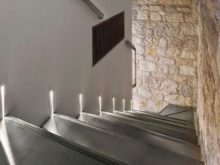
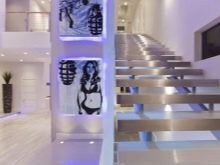
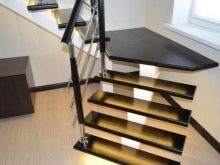
How to choose?
To navigate the huge range of lighting fixtures for lighting staircases, it is important to have an idea of the main types of lamps and their performance.
- Neon lights are used to create soft light that does not cast a shadow. With such lighting, you can fearlessly move up the stairs both during the day and at night. Pros: duration of operation. Cons: due to the fragility of the lighting element, additional protection of the lamp from external influences will be required.
- Halogen light sources provide good brightness and uniform distribution of the luminous flux. Cons: strong heating, therefore it is important to exclude interaction of halogen lamps with the surface of other objects. Voltage drops provoke their rapid burnout.
- LED lamps occupy a leading position in the rating of devices that illuminate stairs. They are characterized by minimal heating and long service life. The popularity of LED luminaires is also due to the extensive possibilities of multi-colored design of structures of any height and shape.
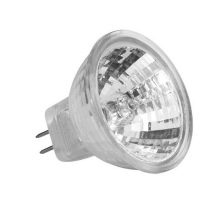
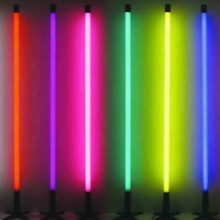
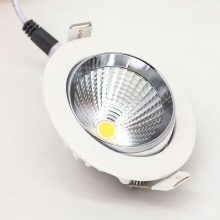
To emphasize the beauty of wooden structures, a yellowish light is used, in which the wood will delight the eye with pleasant natural shades.
Metal products are transformed in bright white light, which, reflected from the metal surface, creates a whimsical play of glare.
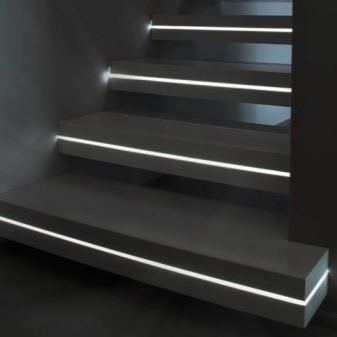
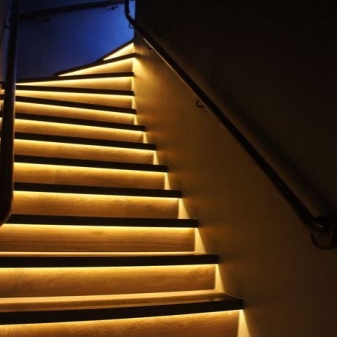
Beautiful interiors
The photo gallery presents examples of the organization of staircase lighting in city apartments and country houses:
- lighting of the stairs in the cottage;
- lighting of the stairs to the second floor;
- original lighting of the steps;
- combined lighting.
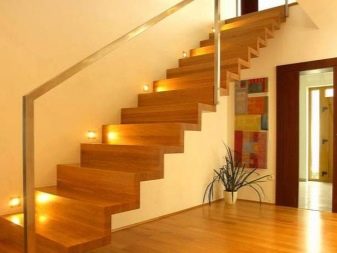

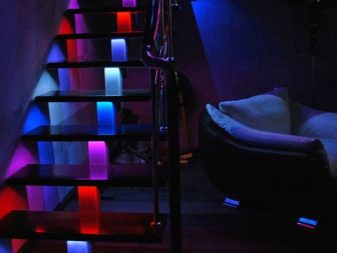
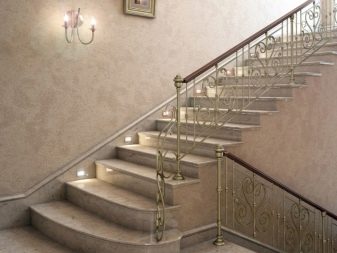













The comment was sent successfully.